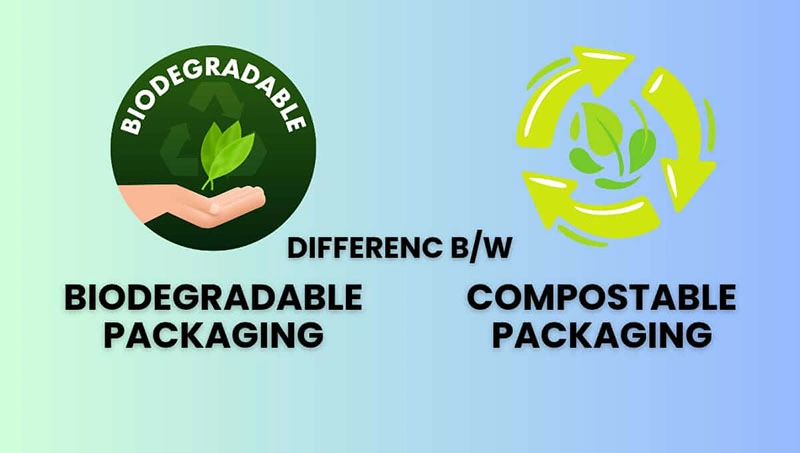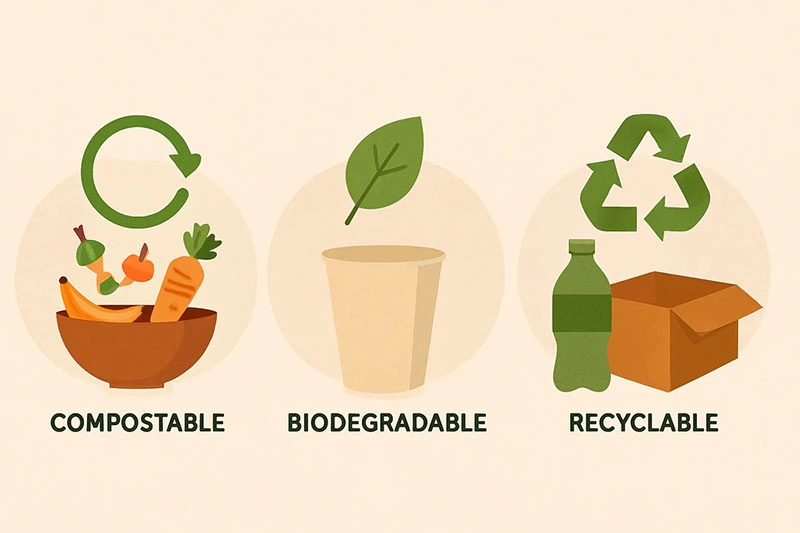If you work in the packaging or export industry, you’ve probably heard of the terms biodegradable and compostable, but it’s easy to confuse the two. This article will help you quickly distinguish the two and avoid confusion.
Last updated: October 2025 | Estimated reading time: 7 minutes

In this article you will learn:
- Differ degradation environment of biodegradable and compostable
- Differ composition of biodegradable and compostable
- Degradation time and end products biodegradable and compostable
- Certificate standards of biodegradable vs compostable
- Which one is better for packaging and exports?
What is the difference between biodegradable and compostable?
Degradable: It can decompose on its own in the natural environment. Over time, it is impossible to control what the final decomposition products will be.
Compostable materials: can decompose quickly under specific conditions (temperature, moisture, oxygen) and do not leave toxic residues.
All compostable materials are biodegradable, but not all biodegradable materials are compostable.
For you, this means:
- “Biodegradable” will eventually degrade.
- “Compostable” can completely disappear within 180 days.

Comparison of biodegradable and compostable certification standards
| Type | Standard | What It Proves | Real-World Meaning |
|---|---|---|---|
| Industrial compostable | EN13432 (EU) / ASTM D6400 (US) | Fully disintegrates within 180 days at 58°C | Meets EU export requirements for compostable packaging |
| Home compostable | OK Compost HOME | Breaks down below 30°C and contains no heavy metals | Suitable for home composting systems |
| Biodegradable | ISO 14855 | Can partially biodegrade | Slower decomposition and may leave residues |
Tip: Without the above certification, your packaging cannot be labeled “compostable” in the European and American markets.
How do their decomposition environments and times differ?
Compostable materials require controlled environments: temperature, humidity, and oxygen levels.
Biodegradable materials decompose naturally, but this may take several years.
| Material | Environment Needed | Approx. Breakdown Time | What It Means for Exporters |
|---|---|---|---|
| PLA (corn-based plastic) | Industrial composting | 2–4 months | If you have access to composting facilities, this is an ideal eco material. |
| PBAT (biodegradable plastic blend) | Industrial composting | 3–6 months | Compostable but higher cost. |
| Kraft paper | Natural environment | 4–8 weeks | Naturally biodegradable. |
| Oxo-degradable plastic | UV light + high heat | Years | Breaks into microplastics and is not truly eco-friendly. |
Real case: EU customs often reject packaging marked only as “biodegradable” because they lack EN13432 or ASTM D6400 certificates and are therefore considered “greenwashing”.
What is the final product of decomposition?
Degradable: If it contains oxidizing additives, it may leave behind microplastics.
Compostable: It is completely converted into CO₂, water, and biomass, harmless to the soil.
That’s why more and more European buyers are asking for “compostable paper bowls” or “no PLA coating packaging”. You can check out our custom paper bowls for more information.
Practical advice for exporters:
- Use compostable materials such as PLA, PBAT, CPLA, etc.
- Mark the compost certification logo and number on the packaging.
- We offer both industrial compostable and home compostable versions for you to choose from.
A UK importer rejected coffee cups with PLA coating because they could only be called “bio-based” and not truly “compostable.” Visit to see more paper cups.
Is human intervention required?
Compostable materials are required. This is where most people get confused.
- Biodegradable materials: Degrade naturally, but may take years to break down in a landfill or ocean.
- Compostable materials: Must be composted in a temperature range of 50–60°C, maintaining oxygen and humidity levels.
Industry insight: If there are no composting facilities nearby, the environmental benefits of compostable packaging will be greatly reduced.
Supply chain and transportation impacts
| Factor | Biodegradable | Compostable | What It Means for You |
|---|---|---|---|
| Heat and humidity resistance | Strong | Weak | Requires desiccant during storage or transport. |
| Shelf life | 12–24 months | 6–12 months | Compostable materials age faster. |
| Shipping conditions | Standard | Temperature-controlled | Prevents moisture damage during transportation. |
Which one is better for packaging and exporting?
| Goal | Better Choice | Reason |
|---|---|---|
| Quick breakdown (controlled environment) | Compostable | Breaks down cleanly, meets EU/US eco regulations. |
| Long-term storage & sea shipping | Biodegradable / Paper + PE | Higher stability for transport and shelf life. |
| Eco-certification | Compostable (certified) | Complies with market access and legal requirements. |
| Cost advantage | Biodegradable | Lower production cost. |
Whenever a customer asks for eco-friendly packaging, we ask if it’s landfill-safe or compostable.
Market trends in 2025
By 2025, over 60% of European retailers will require their suppliers to use certified compostable or plastic-free packaging (Source: European Bioplastics Association). The global compostable packaging market is growing at a compound annual growth rate of 14%, primarily driven by the EU Green Deal.
Latest industry trends:
- PLA-free coated paper is gradually replacing traditional PE film
- Water-based inks/soy inks become the new standard in printing
- OK Home Compost certification is becoming increasingly popular for retail packaging
The European market is shifting towards compostable packaging, but many developing countries still lack composting systems. Therefore, you need to consider your specific situation and choose the most environmentally friendly packaging that suits you.
FAQs
Compostable materials can completely decompose in a controlled environment; biodegradable materials decompose slowly and may leave microplastics.
Yes, but it cannot be labeled “compostable” unless it has passed EN13432 or ASTM D6400 certification.
Biodegradable packaging costs 1.5–3 times less, but compostable materials meet European and American environmental certifications and can pass import inspections.
Do not exceed 80°C. We recommend using water-based or soy inks, as this will damage the PLA structure.
Conclusion
- Degradable = degrades slowly and naturally, possibly leaving residue
- Compostable = decomposes quickly and completely, but requires an industrial composting environment
- You need to check EN13432 / ASTM D6400 / OK Home Compost certification when importing
- Make your choice based on the transportation environment, your local regulations, and storage cycle
Don’t mistake “biodegradable” for a marketing term. Starting in 2025, many importers will ask to see the complete certification documents.
About XiangGe Package
We are XiangGe Package, a professional, eco-friendly packaging manufacturer with over 10 years of export experience.
We offer biodegradable, compostable, and recyclable paper packaging suitable for industries like F&B, retail, and e-commerce.
Our materials comply with EN13432, ASTM D6400, and FSC standards, ensuring smooth customs clearance for every export.
For samples or packaging solutions, please contact us.
Last updated: October 2025
Recommended internal links:

